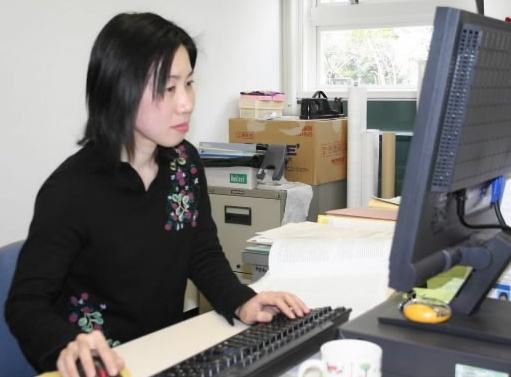Special Series: 60 Years of RERF, Part I [3]
Jun. 30, 2010
Moving beyond its past: Shortage of successors
by Hisashi Konoike, Staff Writer
This feature series on the past and future of the Radiation Effects Research Foundation (RERF) originally began to appear in the Chugoku Shimbun in February 2007.
Future of RERF uncertain
In a laboratory of the Department of Epidemiology in the Radiation Effects Research Foundation (RERF), Dr. Ritsu Sakata, 39, a young researcher, was quietly reading a scientific paper from overseas in a room that accommodates just two desks. In April 2006, Dr. Sakata moved to RERF from Kurume University Biostatistics Center, which has formed a research partnership with RERF. "The research here has a clear goal, and is being watched closely," she said in an upbeat tone. "It's challenging work."
The average age of researchers at RERF is 48.7. Among the 46 researchers now at RERF, there is only one in their 20s. Even those in their 30s number only six. Most of those who are central to RERF's research are over 50, and the shortage of successors is becoming a serious concern.
The personnel administrator at RERF, who is struggling with the issue, said, "Even when we advertise for researchers, it's difficult to secure them. There aren't so many people interested in this field of research. Besides, a focus on epidemiological surveys may lack appeal."
The reduction in personnel has continued. The Japanese government, in its unofficial announcement of the budget for 2005, called for RERF to cut six jobs a year for four years, starting from fiscal 2006. In order to safeguard its research, the cuts have been targeted at general office employees, with staff members being encouraged to resign. The number of general offfice employees has fallen by roughly 50 over the past ten years, with the current number standing at 203.
"Since I joined RERF 14 years ago, five or six people have retired in my section. But there has been no recruitment for the vacant positions," said Misae Sora, 48, chief secretary of the RERF Labour Union. It is the general office workers who support the researchers, and there has been no recruitment of college graduates for the last five years. As Masaaki Imanaka, leader of the RERF Labour Union, said, "We will lose our appeal as a U.S.-style institute without the support of the staff. It is different in Japanese research institutes, where researchers must do everything for themselves." A weakened support system could shake the very ability of RERF to function.
Judging from the current situation with regard to investment and the distribution of personnel, some experts hold that the government probably places the National Institute of Radiological Sciences in Chiba at the center of radiological research.
In the face of these difficulties, RERF has formed a research partnership program with the University of Washington, in the United States, and Kurume University, in Japan. The program has been presented as a means to secure researchers.
Expectations for Dr. Sakata, the first researcher dispatched through the program, are high. Furthermore, joint research between six researchers from the University of Washington and RERF is likely to take shape later this year.
However, lingering doubts remain that moves such as the research partnership program are merely stopgap measures, as the future vision for RERF has yet to be set. As Mr. Imanaka pointed out, "We do not know the view of the government. How does it see the future of RERF? This is the fundamental issue."
RERF's research, at present, has a definite end. The A-bomb survivors are aging, and their numbers decreasing. There is feeling in some quarters that RERF should expand its operations to include the research and treatment of those exposed to radiation, both home and abroad, and use the data accumulated over the years more openly.
Will RERF be able to use its data for the benefit of all human beings? The institute is also standing at a crossroads with regard to maintaining its personnel.
(Originally published March 1, 2007)








